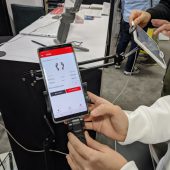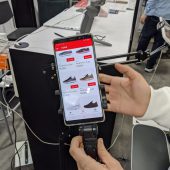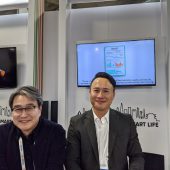If you hear “start-up” and think “Silicon Valley,” then you need to expand your horizons. There are a tremendous number of places where new ideas are bringing massive improvements to how we live around the world. The Seoul Smart City and Smart Life pavilion showcased for us some very exciting ideas coming out of Korea that are worth following closely! Here are five that piqued our interest.

Dot Watch
It is easy to update information when everything is based on sight. From smartwatches to interactive displays in hotels, restaurants, and malls, the world is based on being able to disseminate information visually. It is not as easy for the visually impaired, and Dot Incorporation has a solution with their dynamic Braille based devices, from smartwatches to interactive pads.
The Dot Watch is the world’s first Braille based smartwatch, where Dot’s proprietary technology allows the watch face to be raised for the time, and even receive smartphone notifications and texts. If you are studying braille, the Dot Watch can help, too. The Dot Watch is available now for $399.
Perfitt
What’s your shoe size? Chances are that wasn’t one answer but several — you wear one size in this brand, but in another brand, you’re a half-size off, and then this third brand never seems to fit your heels right. Sound familiar? It’s an issue we all have, and Perfitt has an AI solution to make shoe shopping involve a lot less guesswork.
They use an Android or iOS app to measure your feet from several angles, and then from there, the AI determines not only your shoe size but also which brands fit you best and what size to choose for each brand. It’s an opportunity for both consumers and shoe stores to ensure a perfect fit! The Perfitt app is available now for Android and iOS.
SmarT Diagnosis CardiVu
They say the eyes are the window to your soul. In the case of SmarT Diagnosis, they mean that fairly literally, as they can measure your heart rate via the front-facing camera in your smartphone. Even better, the CardiVu app runs in the background, so you can continue to use your phone like normal and it notifies you when the analysis is complete.
By making it so simple, the goal is to use it daily and compile an ongoing analysis of your heart health over time. The idea of eye health as a link to heart health is not a new one, but this does make measuring your heart rate painless, and without a second device like a smartwatch or fitness tracker. If you’re looking to quantify your health over time and want an easy way to include heart health, this is it! The CardiVu app will be available in February 2020.
NUVI Labs
One of the hardest things when it comes to healthy eating is quantifying the amount on your plate and how that translates in terms of calories. Sure, if you cook all your own food and weigh it out religiously you can get pretty accurate, but that’s a lot more difficult in a cafeteria type scenario. NUVI Labs has a proprietary algorithm that can snap a photo of a tray of food and drink, and from there extrapolate the calories as well as provide information on how much exercise burns off the meal.
The goal is not to shame anyone or make you feel like lunch should immediately be followed by a lively 2-hour swim. Instead, it provides a visual explanation of the trade-offs of your meal. It’s especially aimed at children in cafeterias, as it’s a way to gently teach kids the health “cost” of each food component.
Neosapience TypeCast
Translating the written word to the spoken word is not easy. Generally, a computer reading things aloud has a bit of an artificial sound to it, like how Siri reads angry texts in a sociopathic monotone. But Neosapience is creating the deep fake of audio, with an AI that can clone voices in different languages. Currently, it can handle Korean and Japanese, though the company says more languages are coming.
We saw Morgan Freeman and Donald Trump “speaking” in Korean and even “singing” in Korean with BTS — and the mimicry was uncanny! While this does raise some serious privacy and security concerns, it has a lot of practical considerations. On a large scale, this could make audiobooks cheaper to produce and allow movies to be translated into other languages without losing the authenticity of the actors’ voices.












